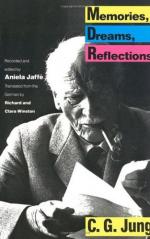
|
| Name: _________________________ | Period: ___________________ |
This test consists of 15 multiple choice questions and 5 short answer questions.
Multiple Choice Questions
1. What did Jung feel when his parents brought home a baby sister?
(a) Hatred.
(b) Disinterested disappointment.
(c) Competitive urges.
(d) Ownership of the baby.
2. What did Jung feel was true about his childhood experiences?
(a) They disappeared and never troubled him again.
(b) There was a degree of eternality to them.
(c) They were fixed in time and finite.
(d) They haunted him until he unlocked their meaning.
3. What was Jung's family like by the time he met Freud?
(a) He was divorced with two children.
(b) He was unmarried.
(c) He was married with one child.
(d) He was married with five children.
4. Jung claims that the unconscious is the source of what?
(a) Consious activity and behavior.
(b) Desires.
(c) Lusts.
(d) Fantasies and daydreams.
5. What did Jung find as he applied his new approach to other cases?
(a) What worked for one patient was hardly ever useful with another.
(b) Each case was unique.
(c) He had to fight the administration of the hospital.
(d) Most patients responded to the same change in treatment.
6. Where did Jung feel closest to God?
(a) In church.
(b) In school.
(c) In nature.
(d) At home.
7. Where did Jung attend university?
(a) Basel.
(b) Geneva.
(c) Berlin.
(d) Munich.
8. What profession did Jung's uncles work in?
(a) They were engravers.
(b) They were bookkeepers.
(c) They were ministers.
(d) They were parsons.
9. What did Jung think about God?
(a) He thought that God was just a character in fairy tales.
(b) He thought God existed and was both kind and terrible.
(c) He thought God was wrathful and harsh.
(d) He thought God was essentially love and goodness.
10. What did the event convince Jung to believe?
(a) That ordinary events are misleading.
(b) That he was essentially powerless.
(c) That men are strangers to themselves.
(d) That the impossible can occur.
11. What significance does the red stone have for Jung?
(a) He identified it with God.
(b) He had used it to represent an altar.
(c) He had thought it spoke to him.
(d) He had found it when he had had a revelation.
12. How was mental health practiced when Jung entered it?
(a) It was at the heart of scientific debates about psychology.
(b) It was in an obscure boundary-land between science and crime.
(c) It was outside of science.
(d) It was closer to running a prison.
13. Where was Jung raised?
(a) In Germany near the Dutch border.
(b) In England near the coast.
(c) In France near the Swiss border.
(d) In Switzerland near the German border.
14. What was Jung afraid of as a child?
(a) Men in large groups.
(b) Men in black frocks.
(c) Protestants.
(d) His father.
15. What did Jung expect for his career and maturity?
(a) Travels and exploration before he settled down.
(b) A lifetime of intellectual exploration and travel.
(c) One career and one wife.
(d) He planned to renounce worldly things and enter the church.
Short Answer Questions
1. What did Jung say that he thought had pushed Nietzsche over the brink into insanity?
2. How did Jung refer to his autobiography while it was being written?
3. What did Freud want from Jung?
4. Who encouraged Jung to take a new subject in his writing?
5. Who did Jung consult with about his feelings about God and religion?
|
This section contains 569 words (approx. 2 pages at 300 words per page) |

|




